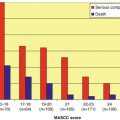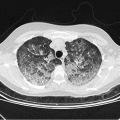L. monocytogenes a
S. pneumoniae
Staphylococcus spp.
Pseudomonas spp.
Gram-negative aerobic bacilli
N. meningitidis
Candida spp. b
Aspergillus spp.
Cryptococcus neoformans b
Varicella zoster virusc
Herpes simplex virusc
Cytomegalovirus
P. jirovecii a
Typical and atypical mycobacteria
As a practical consequence, in patients with fever of unknown origin after purine analog treatment, peripheral blood should be checked for CMV reactivation (pp65 or preferably PCR); patients with fever and lung infiltrates should undergo bronchoscopy and bronchoalveolar lavage (BAL) to be examined for P. jirovecii, CMV, mycobacteria, and filamentous fungi in addition to conventional bacteriology. Please note that the determination of CMV copies in peripheral blood does not replace testing of respiratory secretions and that in BAL, nucleic acid amplification (PCR) alone may only exclude CMV or P. jirovecii infection, if negative, but does not prove these infections, if positive.
For antimicrobial treatment in these patients, a broad-spectrum beta-lactam antibiotic with activity against P. aeruginosa and S. aureus, selected on the basis of the local in vitro susceptibility patterns, should initially be administered. Once results of microbiological analyses are available, appropriate adjustment of this initial treatment is required. In single patients without reliable TMP-SMX prophylaxis, who have typical pulmonary infiltrates sparing out subpleural spaces and a rapidly increased lactate dehydrogenase (LDH) in blood, preemptive start of high-dose intravenous TMP-SMX may be indicated before BAL results are known or even before bronchoscopy is performed. BAL samples remain positive for P. jirovecii several days after initiation of TMP-SMX therapy [15].
3.2 Monoclonal Antibodies
3.2.1 Anti-CD20 Antibodies
Monoclonal antibodies targeting the CD20 molecule on the surface of lymphoid cancer cells, predominantly rituximab but also ofatumumab and obinutuzumab (GA101), are routinely included in the treatment of patients with CD20-positive B cell lymphoma or, in case of rituximab, acute lymphoblastic leukemia. They cause a rapid depletion of CD20-positive B cells from peripheral blood; however, this is not associated with a significant increase in infection rates [7, 10, 16]. When rituximab is used for post-remission maintenance treatment in lymphoma patients, the risk of fever and infections is higher than in comparable patients without rituximab maintenance [17, 18], but a characteristic pattern of infectious problems, e.g., as a consequence of immunoglobulin deficiency, has not been reported. Therefore, a specific diagnostic or therapeutic approach to patients who develop fever and infection after CD20 antibody treatment cannot be recommended. Severe hypogammaglobulinemia, present in many patients with indolent B cell lymphomas independently from CD20 antibody treatment, may give reason for immunoglobulin G substitution.
Apart from opportunistic bacterial or fungal infections, the risk of hepatitis B virus (HBV) reactivation is considerably increased (approximately fivefold) in rituximab-treated patients [19, 20], as is the risk of hepatitis C virus (HCV) reactivation [21]. As a consequence, serological screening for HBV and HCV is recommended for patients to be treated with these CD20 antibodies [22], and transaminases should be monitored in patients with a positive HBV or HCV serology. Apart from HBV and HCV reactivation, also the risk of progressive multifocal leukoencephalopathy (PML) has reportedly been increased in rituximab recipients, predominantly those with lymphoproliferative disease [23], so that in patients with signs or symptoms of central nervous system, a search for JC virus replication may be considered.
3.2.2 Alemtuzumab (Anti-CD52 Antibody)
The administration of alemtuzumab (Campath), typically given for treatment of B-CLL or T cell lymphoma, results in a severe lymphocytopenia lasting for more than a year. Patients with these lymphoproliferative malignancies frequently have an inherent immune deficiency, so that the combined risk of opportunistic infections is very high; however, it has been clearly shown that patients treated early in the course of their disease with alemtuzumab have a markedly lower infection rate as compared to patients with far advanced, relapsed, or refractory lymphoma [24, 25]. When given for first-line treatment in 41 patients with B-CLL, who received antimicrobial prophylaxis with TMP-SMX, acyclovir, and fluconazole, CMV reactivation has been the predominant infectious event [25]. In contrast infectious complications were observed in 55 % of 93 patients undergoing alemtuzumab therapy for relapsed and refractory CLL [26]. TMP-SMX and acyclovir prophylaxis as well as monitoring of blood samples for CMV reactivation (weekly or every other week) is mandatory. A high incidence of infections must be expected also in patients receiving systemic antimicrobial prophylaxis. Among infectious events occurring in alemtuzumab recipients, CMV reactivation and other viral infections are predominant with 40–45 %, followed by bacterial (35–40 %) and fungal (17–21 %) infections including PcP [27]. Also protozoal infections and PML have been reported in these patients [28]. Severe and fatal infections have been observed particularly in patients with B-CLL given alemtuzumab for consolidation after successful remission induction [29, 30]. A specific guideline on the use of alemtuzumab, particularly with respect to severe infections, is available [31].
Table 3.2 shows infections and pathogens documented in patients who underwent alemtuzumab treatment.
Cytomegalovirus |
Herpes simplex virus |
Varicella zoster virus |
Human herpesvirus 6 |
Epstein-Barr virus |
Parvovirus |
Influenza |
Septicemia |
Pneumonia |
Meningitis |
Tuberculosis |
Cellulitis |
Fever of unknown origin |
Pneumocystis pneumonia |
Aspergillosis |
Systemic candidiasis |
Mucormycosis |
Cryptococcosis |
Fusariosis |
Scedosporiosis |
Cryptosporidiosis |
Microsporidiosis |
Diagnostic procedures to be considered in patients with fever or other signs of infection after alemtuzumab treatment must take the extremely broad spectrum of potential pathogens into account. Apart from conventional microbiological procedures, applied on blood cultures or other body fluids according to the respective clinical syndrome, serologic and molecular methods to detect active viral replication or to exclude pulmonary tuberculosis will often be required. In patients with persistent fever and/or signs of infection despite broad-spectrum antimicrobial treatment, invasive procedures such as bronchoscopy, fine-needle biopsy, lumbar puncture, or colonoscopy must be considered. Similar to patients who underwent purine analog treatment, antimicrobial treatment is initiated with a broad-spectrum beta-lactam antibiotic and later modified according to diagnostic findings or preemptively with respect to the presumed causative pathogen(s).
3.2.3 Antibodies to Tumor Necrosis Factor Alpha (TNF-Alpha)
Tumor necrosis factor-alpha mediates essential inflammatory responses to microbial pathogens, including release of proinflammatory cytokines such as interleukin-1beta, interleukin-6, interleukin-8, and monocyte chemoattractant protein-1 as well as of adhesion molecules and the activation of phagocytosis, T cell activation, and stimulation of antibody production by B cells. Their immunomodulatory effects are mediated via downregulation of TNF-induced expression of pattern-recognition receptors, reduction of gamma interferon production, apoptosis of monocytes, and an impairment of TNF-mediated granuloma formation [33]. TNF antagonists such as infliximab, etanercept, adalimumab, or certolizumab pegol are mainly used in patients with severe rheumatic diseases and chronic inflammatory bowel disorders, but infliximab or etanercept are also given to allogeneic hematopoietic stem cell transplant recipients with severe graft-versus-host disease (GVHD) refractory to more routine immunosuppressive treatment [34–37]. Only the latter patient group will be addressed here. While these patients are at extremely high risk of opportunistic infections already because of their underlying conditions and all of them are treated not only with TNF antagonists but also a broad array of other immunosuppressants including high doses of glucocorticoids, it has been demonstrated that the addition of the TNF antagonist infliximab to GVHD management with cyclosporine and methotrexate resulted in a significant increase of bacterial and fungal infections [38]. Published reports and reviews suggest that the risk of bacterial, viral, and fungal infection is increased in GVHD patients treated with TNF antagonists [34], and this risk apparently was higher among patients treated with infliximab than with etanercept [33]. Gram-negative as well as gram-positive bacterial infections have been documented in these patients, and among viral infections, CMV as well as respiratory viruses play a relevant role [34]. Invasive fungal infections caused by Candida spp., Aspergillus spp., and Cryptococcus neoformans, but also endemic mycoses (in affected areas), primarily histoplasmosis and coccidioidomycosis, have been reported in these patients [33]. The risk of these infections increases at a hazard ratio of 13.6 (95 % confidence interval, 2.3–80.2) in patients with severe GVHD treated with infliximab [39].
Similar to the diagnostic recommendations given above for patients treated with alemtuzumab, a simple algorithm to be applied for the clinical workup of patients fever or other signs of infection after anti-TNF treatment for GVHD cannot be given, because the whole spectrum of viral, bacterial, fungal, and protozoal pathogens must be taken into consideration – also in patients undergoing systemic antimicrobial chemoprophylaxis. With respect to their high incidence and poor prognosis after deferred treatment, opportunistic mycoses should aggressively be addressed in these patients, and systemic antimicrobial treatment should very early include a broad-spectrum antifungal agent such as liposomal amphotericin B or voriconazole.
Stay updated, free articles. Join our Telegram channel

Full access? Get Clinical Tree






